Improving Wind Power Generation Forecasts: A Hybrid ANN-Clustering-PSO Approach
Abstract
:1. Introduction
Proposal and Main Contribution
2. Methodology and CPA-WF Model
3. Wind Speed Forecasting Procedure
- 1.
- define the topology of the neural network;
- 2.
- randomly initialize the parameters of K CPA-WF (weights and biases);
- 3.
- initialize the parameters (velocity and position) and the search space of the PSO according to the topology of the CPA-WF;
- 4.
- run the K CPA-WF and for each particle at each iteration h, a wind speed forecasting is derived; after that, the PSO computes the best position of the ith particle over its history up to iteration h (), and the position of the best particle in the swarm at iteration h ();
- 5.
- calculate for each particle the value of the cost function, as defined in (6);
- 6.
- update the velocity and position of the PSO particles until the cost function is minimized, as described in [49];
- 7.
- set vectors of the best position and velocity that minimize the cost function as weights and biases of the MLP—ANN.
4. Wind Prediction Results and Error Analysis
4.1. Case Study and Input Data
4.2. Wind Speed Prediction Results
4.3. Forecasting Error Analyses
5. Conclusions
Author Contributions
Funding
Data Availability Statement
Acknowledgments
Conflicts of Interest
Abbreviations
| ANN | Artificial Neural Network |
| PSO | Particle Swarm Optimization |
| MLP | Multi-Layer Perceptron |
| MAPE | mean absolute percentage error |
| RMSE | root mean square error |
| RSE | renewable energy sources |
| WPG | wind power generation |
| AR | autoregressive processes |
| ARMA | autoregressive moving averages |
| ARIMA | autoregressive integrated moving averages |
| GP | Gaussian processes |
| WT | wavelet transforms |
| MTGP | multi-task Gaussian processes |
| CDM | combined dynamic factor |
| CFDM | computational fluid dynamic models |
| FL | Fuzzy Logic |
| SVM | Support Vector Machines |
| GA | Genetic Algorithm |
| OP | Observation Point |
| WFP | wind farm plant |
| CPA-WF | Clustered PSO-ANN – Wind Forecasting Method |
| PSO-BP | Particle Swarm Optimization-Back Propagation |
References
- Strielkowski, W.; Civín, L.; Tarkhanova, E.; Tvaronavičienė, M.; Petrenko, Y. Renewable Energy in the Sustainable Development of Electrical Power Sector: A Review. Energies 2021, 14, 8240. [Google Scholar] [CrossRef]
- IEA. World Energy Outlook 2021: Global Status Report; IEA: Paris, France, 2021.
- GWEC Report 2021; Global Wind Energy Council: Brussels, Belgium, 2021.
- Wolniak, R.; Skotnicka-Zasadzień, B. Development of Wind Energy in EU Countries as an Alternative Resource to Fossil Fuels in the Years 2016–2022. Resources 2023, 12, 96. [Google Scholar] [CrossRef]
- Renewable Energy Statistics 2021: Report 2021; International Renewable Energy Agency (IRENA): Masdar City, United Arab Emirates, 2021.
- Ullah, K.; Ullah, Z.; Aslam, S.; Salam, M.S.; Salahuddin, M.A.; Umer, M.F.; Humayon, M.; Shaheer, H. Wind Farms and Flexible Loads Contribution in Automatic Generation Control: An Extensive Review and Simulation. Energies 2023, 16, 5498. [Google Scholar] [CrossRef]
- Prakash, V.; Kushwaha, P.; Sharma, K.C.; Bhakar, R. Frequency response support assessment from uncertain wind generation. Int. J. Electr. Power Energy Syst. 2022, 134, 107465. [Google Scholar] [CrossRef]
- Fitzroy, R. The Weather Book—A Manual of Practical Meteorology; Cambridge Library Collection—Physical Sciences: Cambridge, UK, 2012. [Google Scholar]
- Assaf, A.M.; Haron, H.; Abdull Hamed, H.N.; Ghaleb, F.A.; Qasem, S.N.; Albarrak, A.M. A Review on Neural Network Based Models for Short Term Solar Irradiance Forecasting. Appl. Sci. 2023, 13, 8332. [Google Scholar] [CrossRef]
- Wang, J.; Qin, S.; Zhou, Q.; Jiang, H. Medium-term wind speeds forecasting utilizing hybrid models for three different sites in Xinjiang, China. Renew. Energy 2015, 76, 91–101. [Google Scholar] [CrossRef]
- Kiplangat, D.C.; Asokan, K.; Satheesh Kumar, K. Improved week-ahead predictions of wind speed using simple linear models with wavelet decomposition. Renew. Energy 2016, 93, 38–44. [Google Scholar] [CrossRef]
- Wang, J.; Song, Y.; Liu, F.; Hou, R. Analysis and application of forecasting models in wind power integration: A review of multi-step-ahead wind speed forecasting models. Renew. Sust. Energ. Rev. 2016, 60, 960–981. [Google Scholar] [CrossRef]
- Box, G.E.P.; Jenkins, G.M.; Reinsel, G.C. Time Series Analysis: Forecasting and Control, 4th ed.; Wiley: New York, NY, USA, 2008. [Google Scholar]
- De Alencar, D.B.; de Mattos Affonso, C.; de Oliveira, R.C.L.; Rodriguez, J.L.M.; Leite, J.C.; Filho, J.C.R. Different Models for Forecasting Wind Power Generation: Case Study. Energies 2017, 10, 1976. [Google Scholar] [CrossRef]
- Lydia, M.; Kumar, S.S.; Selvakumar, A.I.; Kumar, G.E.P. Linear and non-linear autoregressive models for short-term wind speed forecasting. Energy Conv. Manag. 2016, 112, 115–124. [Google Scholar] [CrossRef]
- Cai, H.; Jia, X.; Feng, J.; Li, W.; Hsu, Y.; Lee, J. Gaussian Process Regression for numerical wind speed prediction enhancement. Renew. Energy 2019, 146, 2112–2123. [Google Scholar] [CrossRef]
- Haiqiang, Z.; Yusheng, X.; Jizhu, G.; Jiehui, C. Ultra-short term wind speed forecasting method based on spatial and temporal correlation models. In Proceedings of the 6th International Conference on Renewable Power Generation (RPG), Wuhan, China, 19–20 October 2017. [Google Scholar]
- Skittides, C.; Früh, W.G. Wind forecasting using Principal Component Analysis. Renew. Energy 2014, 69, 365–374. [Google Scholar] [CrossRef]
- Vasquez, T. Weather Forecasting Handbook, 5th ed.; Weather Graphics Technologies: Garland, TX, USA, 2002. [Google Scholar]
- Kariniotakis, G. Renewable Energy Forecasting—From Models to Applications, 1st ed.; Woodhead Publishing Series in Energy; Woodhead Publishing: Sawston, UK, 2017. [Google Scholar]
- Ray, P.S. Mesoscale Meteorology and Forecasting; American Meteorological Society: Society Boston, MA, USA; Springer: Berlin/Heidelberg, Germany, 1986. [Google Scholar]
- Pielke Sr, R.A. Mesoscale Meteorological Modelling; International Geophysics Series; Elsevier: Amsterdam, The Netherlands; Academic Press: Cambridge, UK, 2001; Volume 98. [Google Scholar]
- Sanz, S.S.; Perez-Bellido, A.; Ortiz-Garca, E.; Portilla-Figueras, A.; Prieto, L.; Paredes, D.; Correoso, F. Short-term Wind Speed Prediction by Hybridizing Global and Mesoscale Forecasting Models with Articial Neural Networks. In Proceedings of the 8th IEEE International Conference on Hybrid Intelligent Systems, Barcelona, Spain, 10–12 September 2008. [Google Scholar]
- Xie, Y.; Chaoshun Li, C.; Li, M.; Liu, F.; Taukenova, M. An overview of deterministic and probabilistic forecasting methods of wind energy. iScience 2023, 26, 105804. [Google Scholar] [CrossRef] [PubMed]
- Stathopoulos, C.; Kaperoni, A.; Galanis, G.; Kallos, G. Wind power prediction based on numerical and statistical models. J. Wind Eng. Ind. Aerodyn. 2013, 112, 25–38. [Google Scholar] [CrossRef]
- Ahmad, T.; Chen, H. Potential of three variant machine-learning models for forecasting district level medium-term and long-term energy demand in smart grid environment. Energy 2018, 160, 1008–1020. [Google Scholar] [CrossRef]
- Peng, T.; Zhou, J.; Zhang, C.; Zheng, Y. Multi-step ahead wind speed forecasting using a hybrid model based on two stage decomposition technique and AdaBoost-extreme learning machine. Energy Convers. Manag. 2017, 153, 589–602. [Google Scholar] [CrossRef]
- Catalão, J.P.S. Electric Power Systems: Advanced Forecasting Techniques and Optimal Generation Scheduling, 1st ed.; CRC Press: Boca Raton, FL, USA, 2017. [Google Scholar]
- Zhang, C.; Chen, C.L.P.; Gan, M.; Chen, L. Predictive Deep Boltzmann Machine for Multiperiod Wind Speed Forecasting. IEEE Trans. Sust. Energy 2015, 6, 589–602. [Google Scholar] [CrossRef]
- Khodayar, M.; Wang, J. Spatio-Temporal Graph Deep Neural Network for Short-Term Wind Speed Forecasting. IEEE Trans. Sust. Energy 2019, 10, 670–681. [Google Scholar] [CrossRef]
- Kaur, T.; Kumar, S.; Segal, R. Application of Artificial Neural Network for Short Term Wind Speed Forecasting. In Proceedings of the Biennial IEEE International Conference on Power and Energy Systems: Towards Sustainable Energy (PESTSE), Karnataka, India, 21–23 January 2016. [Google Scholar]
- Hu, Q.; Zhang, S.; Yu, M.; Xie, Z. Short-Term Wind Speed or Power Forecasting With Heteroscedastic Support Vector Regression. IEEE Trans. Sust. Energy 2016, 7, 241–249. [Google Scholar] [CrossRef]
- Santamaría-Bonfil, G.; Reyes-Ballesteros, A.; Gershenson, C. Wind speed forecasting for wind farms: A method based on support vector regression. Renew. Energy 2016, 85, 790–809. [Google Scholar] [CrossRef]
- Chen, K.; Yu, J. Short-term wind speed prediction using an unscented Kalman filter based state-space support vector regression approach. Appl. Energy 2014, 113, 690–705. [Google Scholar] [CrossRef]
- Liu, D.; Niu, D.; Wang, H.; Fan, L. Short-term wind speed forecasting using wavelet transform and support vector machines optimized by genetic algorithm. Renew. Energy 2014, 62, 592–597. [Google Scholar] [CrossRef]
- Sharifian, A.; Ghadi, M.J.; Ghavidel, S.; Li, L.; Zhang, J. A new method based on Type-2 fuzzy neural network for accurate wind power forecasting under uncertain data. Renew. Energy 2018, 120, 220–230. [Google Scholar] [CrossRef]
- Nair, K.R.; Vanitha, V.; Jisma, M. Forecasting of wind speed using ANN, ARIMA and Hybrid models. In Proceedings of the IEEE International Conference on Intelligent Computing, Instrumentation and Control Technologies (ICICICT), Kannur, India, 6–7 July 2017. [Google Scholar]
- Eseye, A.T.; Zhang, J.; Zheng, D.; Li, H.; Jingfu, G. A Double-Stage Hierarchical Hybrid PSO-ANN Model for Short-Term Wind Power Prediction. In Proceedings of the 2nd IEEE International Conference on Cloud Computing and Big Data Analysis, Chengdu, China, 28–30 April 2017. [Google Scholar]
- Li, H.; Eseye, A.T.; Zhang, J.; Zheng, D. A Double-stage Hierarchical Hybrid PSO-ANFIS Model for Short-term Wind Power Forecasting. In Proceedings of the 9th Annual IEEE Green Technologies Conference, Denver, CO, USA, 29–31 March 2017. [Google Scholar]
- Catalão, J.P.S.; Pousinho, H.M.I.; Mendes, V.M.F. Short-term wind power forecasting in Portugal by neural networks and wavelet transform. Renew. Energy 2018, 36, 1245–1251. [Google Scholar] [CrossRef]
- Naik, J.; Satapathy, P.; Dash, P.K. Short-term wind speed and wind power prediction using hybrid empirical mode decomposition and kernel ridge regression. Appl. Soft Comp. 2018, 70, 1167–1188. [Google Scholar] [CrossRef]
- Ssekulima, E.B.; Anwar, M.B.; Al Hinai, A.; El Moursi, M.S. Wind speed and solar irradiance forecasting techniques for enhanced renewable energy integration with the grid: A review. IET Renew. Power Gener. 2016, 10, 885–898. [Google Scholar] [CrossRef]
- Finamore, A.R.; Calderaro, V.; Galdi, V.; Piccolo, A.; Conio, G.; Grasso, S. A day-ahead wind speed forecasting using data-mining model—A feed-forward NN algorithm. In Proceedings of the IEEE International Conference on Renewable Energy Research and Applications, Palermo, Italy, 22–25 November 2015. [Google Scholar]
- Finamore, A.R.; Calderaro, V.; Galdi, V.; Piccolo, A.; Conio, G. A Wind Speed Forecasting Model based on Artificial Neural Network and Meteorological Data. In Proceedings of the 16th IEEE International Conference on Environment and Electrical Engineering, Florence, Italy, 7–10 June 2016. [Google Scholar]
- Mazur, A. Artificial Neural Network in EPS Calibration—An Alternative for Linear Regression and for Simple EPS Mean; EUMETNET: Bologna, Italy, 2018. [Google Scholar]
- Bohme, T.; Stapelberg, S.; Akkermans, T.; Crewell, S.; Fischer, J.; Reinhardt, T.; Seifert, A.; Selbach, C.; Van Lipzig, N. Long-term evaluation of COSMO forecasting using combined observational data of the GOP period. Meteorologische Zeitschrift 2011, 119–132. [Google Scholar] [CrossRef]
- Trapp, R.J. Mesoscale-Convective Processes in the Atmosphere; Cambridge University Press: Cambridge, UK, 2013. [Google Scholar]
- Emeis, S. Wind Energy Meteorology—Atmospheric Physics for Wind Power Generation Green Energy and Technology, 2nd ed.; Springer: Berlin/Heidelberg, Germany, 2018. [Google Scholar]
- Olsson, A.E. Particle Swarm Optimization: Theory, Techniques and Applications; Nova Science Pub Inc.: Hauppauge, NY, USA, 2011. [Google Scholar]
- Warner, T.T. Numerical Weather and Climate Prediction; Cambridge University Press: Cambridge, UK, 2012. [Google Scholar]
- Fausett, L.V. Fundamentals of Neural Networks: Architectures, Algorithms, and Applications; Prentice-Hall: Toronto, ON, USA, 1994. [Google Scholar]
- Gan, G.; Ma, C.; Wu, J. Data Clustering: Theory, Algorithms, and Applications; ASA-SIAM Series on Statistics and Applied Mathematics; SIAM, Ed.; Taylor & Francis Group, LLC.: Abingdon, OX, USA, 2007. [Google Scholar]
- Wu, J. Advances in K-Means Clustering—A Data Mining Thinking; Springer: Berlin, Germany, 2012. [Google Scholar]
- Fazelpour, F.; Tarashkar, N.; Rosen, M.A. Short-term wind speed forecasting using artificial neural networks for Tehran, Iran. Int. J. Energy Environ. Eng. 2016, 7, 377–390. [Google Scholar] [CrossRef]
- Viet, D.T.; Phuong, V.V.; Duong, M.Q.; Tran, Q.T. Models for Short-Term Wind Power Forecasting Based on Improved Artificial Neural Network Using Particle Swarm Optimization and Genetic Algorithms. Energies 2020, 13, 2873. [Google Scholar] [CrossRef]
- Kumar, V.; Pal, Y.; Tripathi, M.M. PSO-Tuned ANN-Based Prediction Technique for Penetration of Wind Power in Grid. In Proceedings of the ICRIC; Springer: Jammu, India, 2019. [Google Scholar]
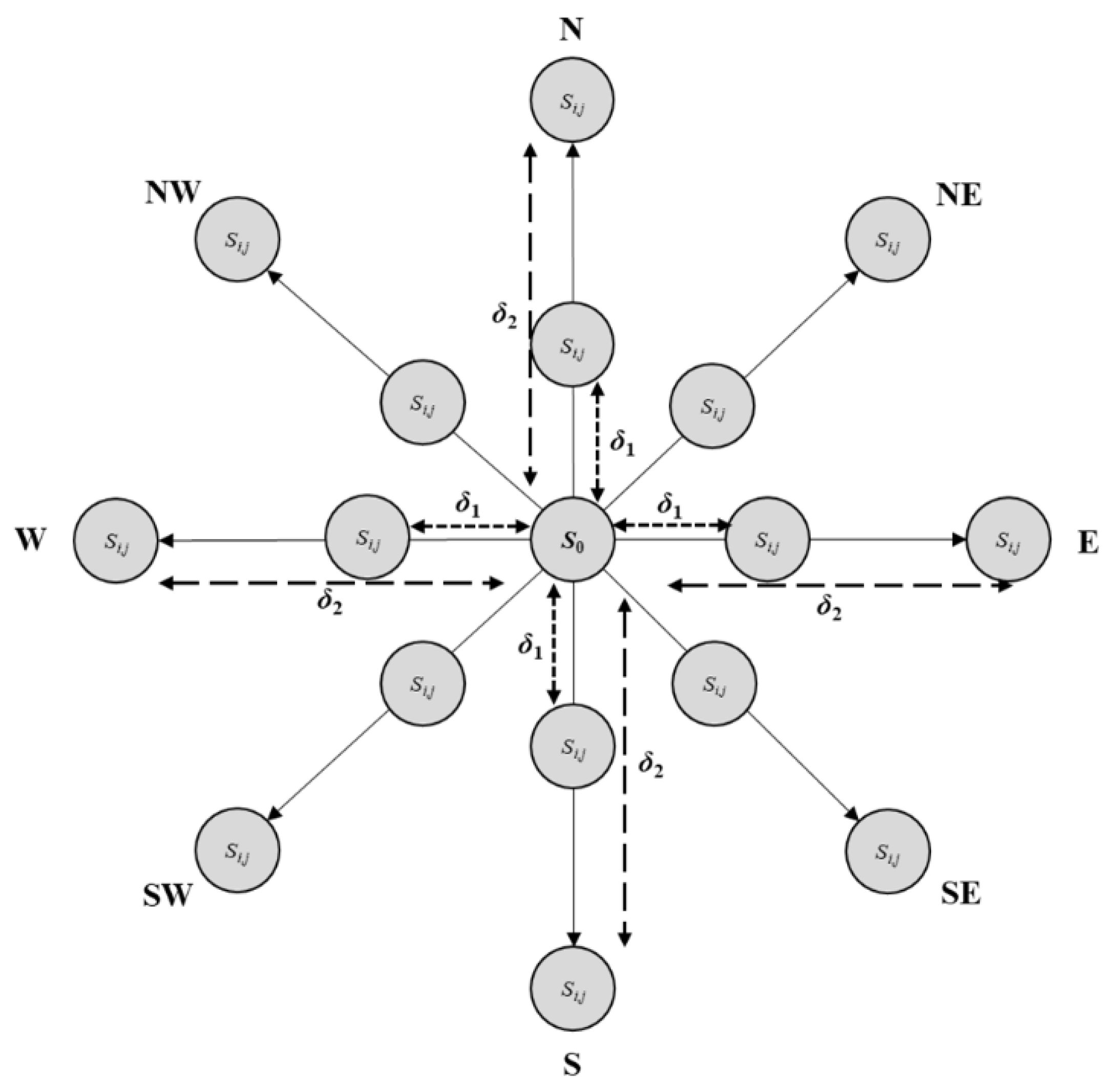


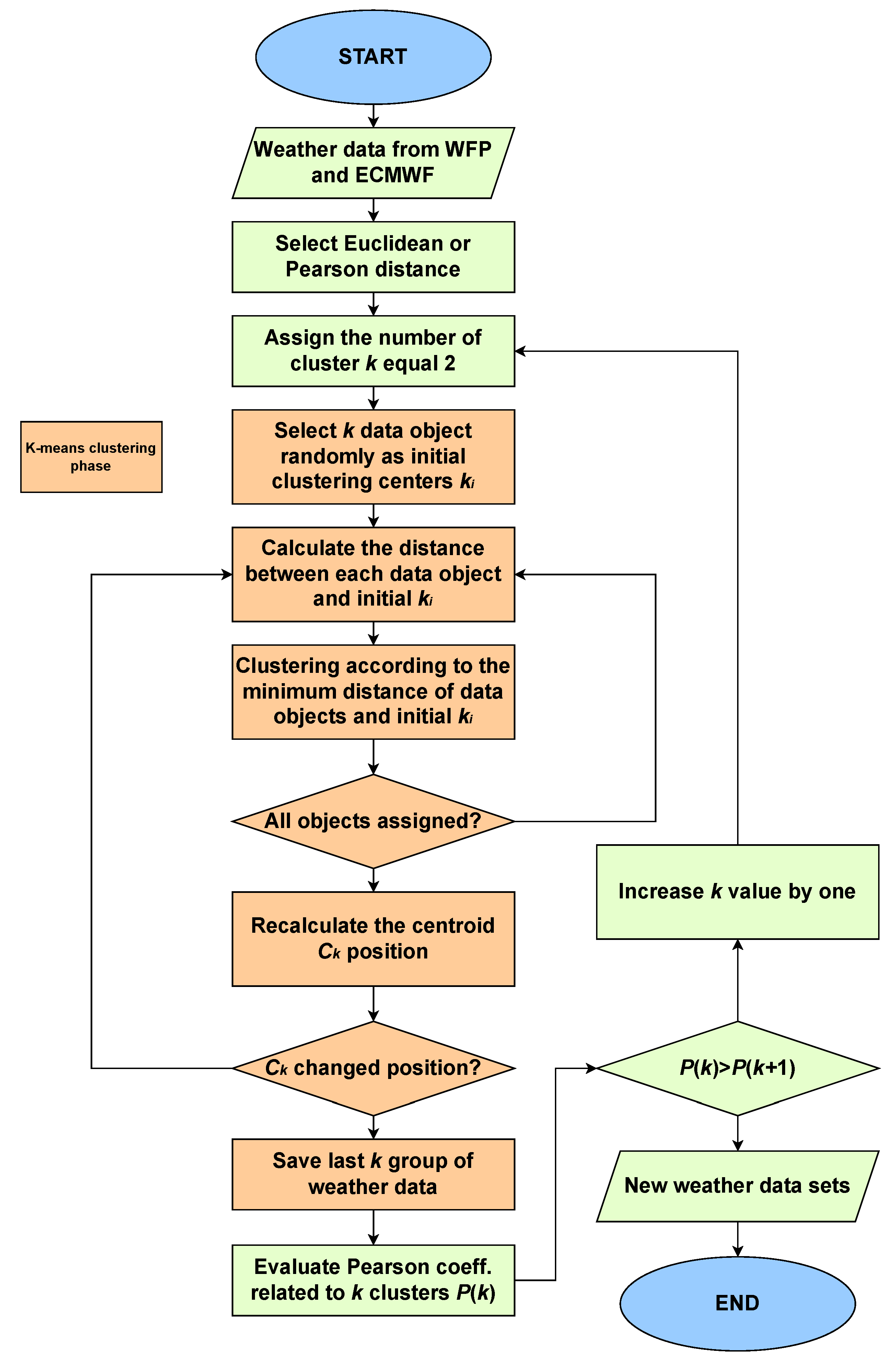
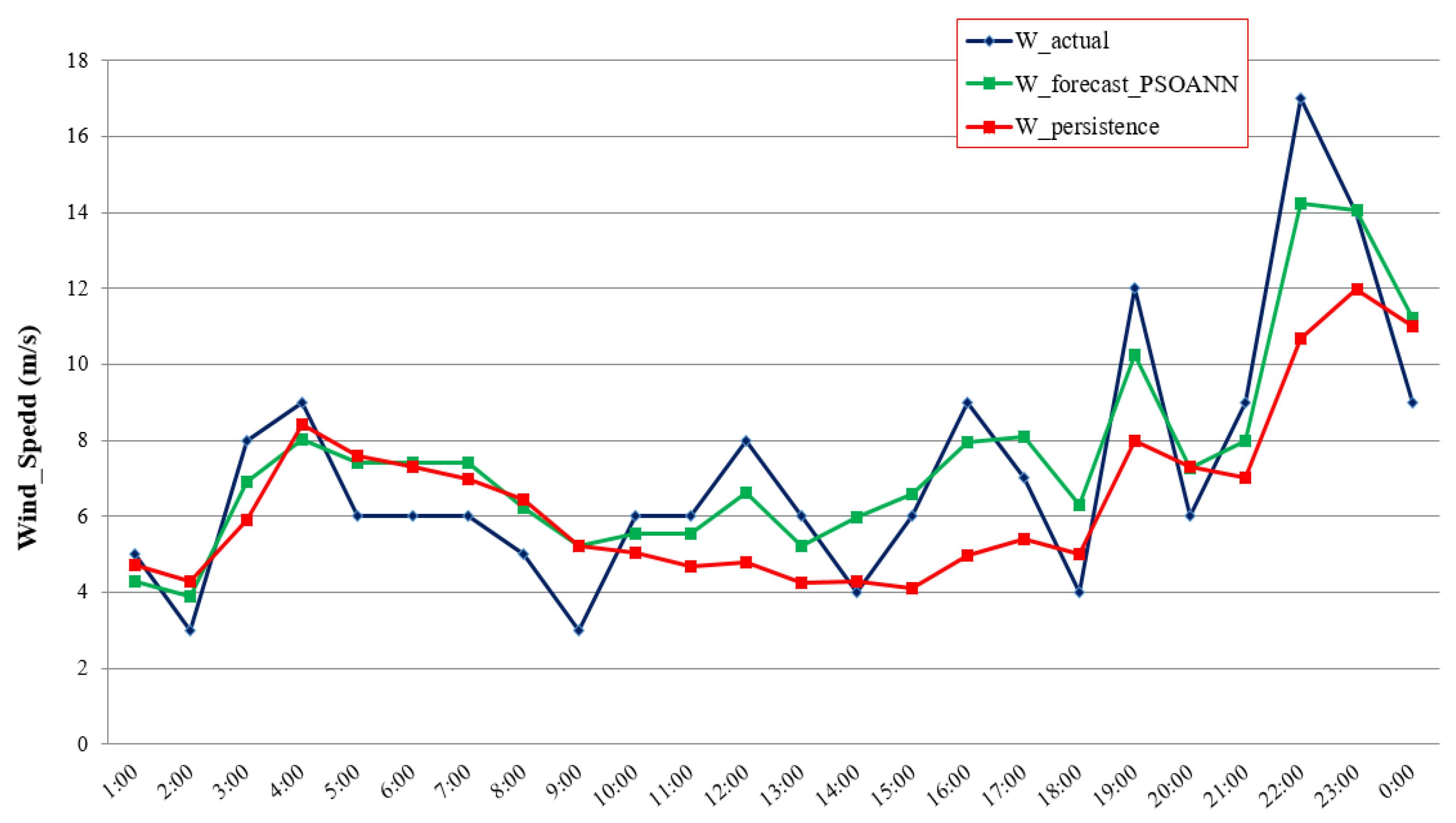
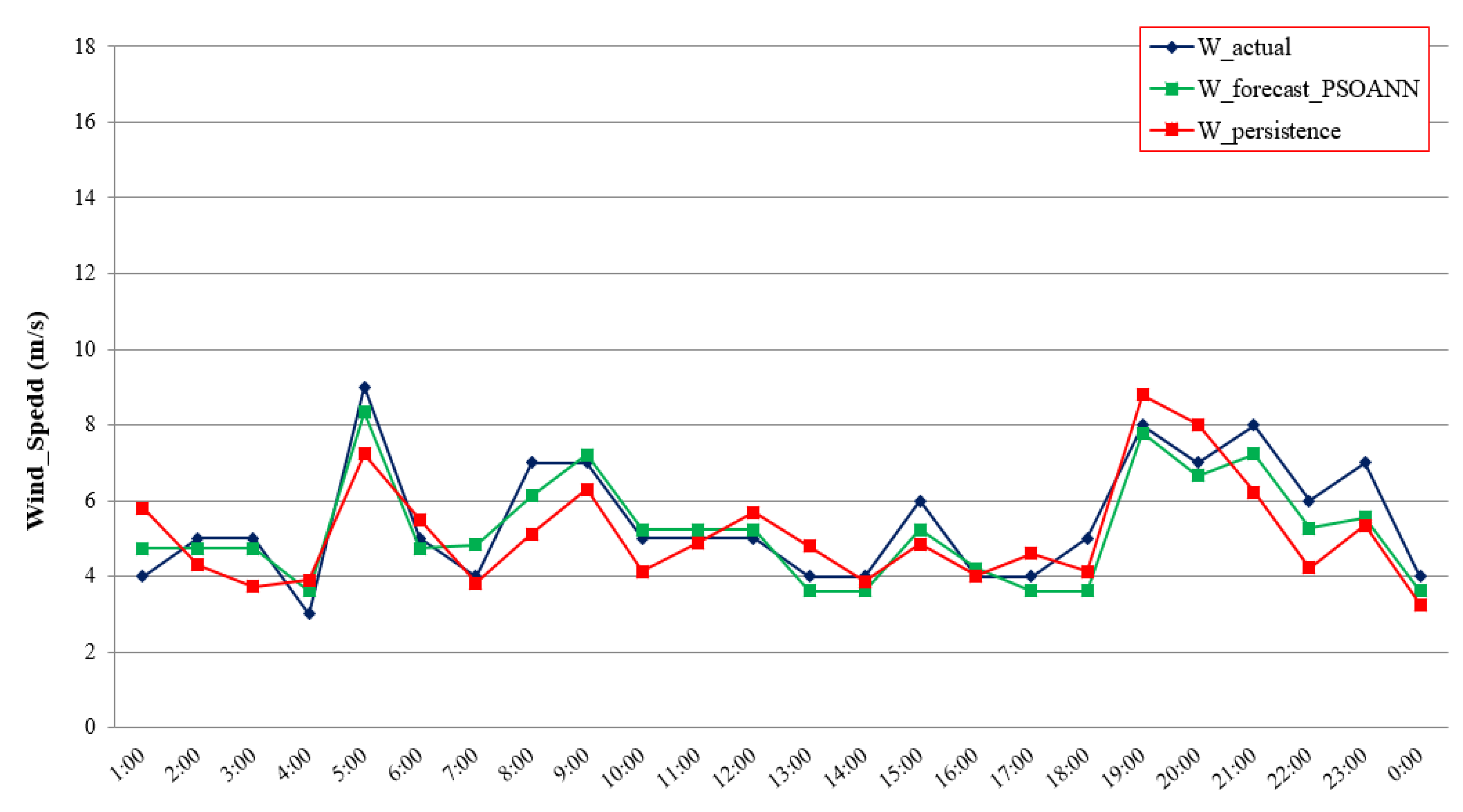
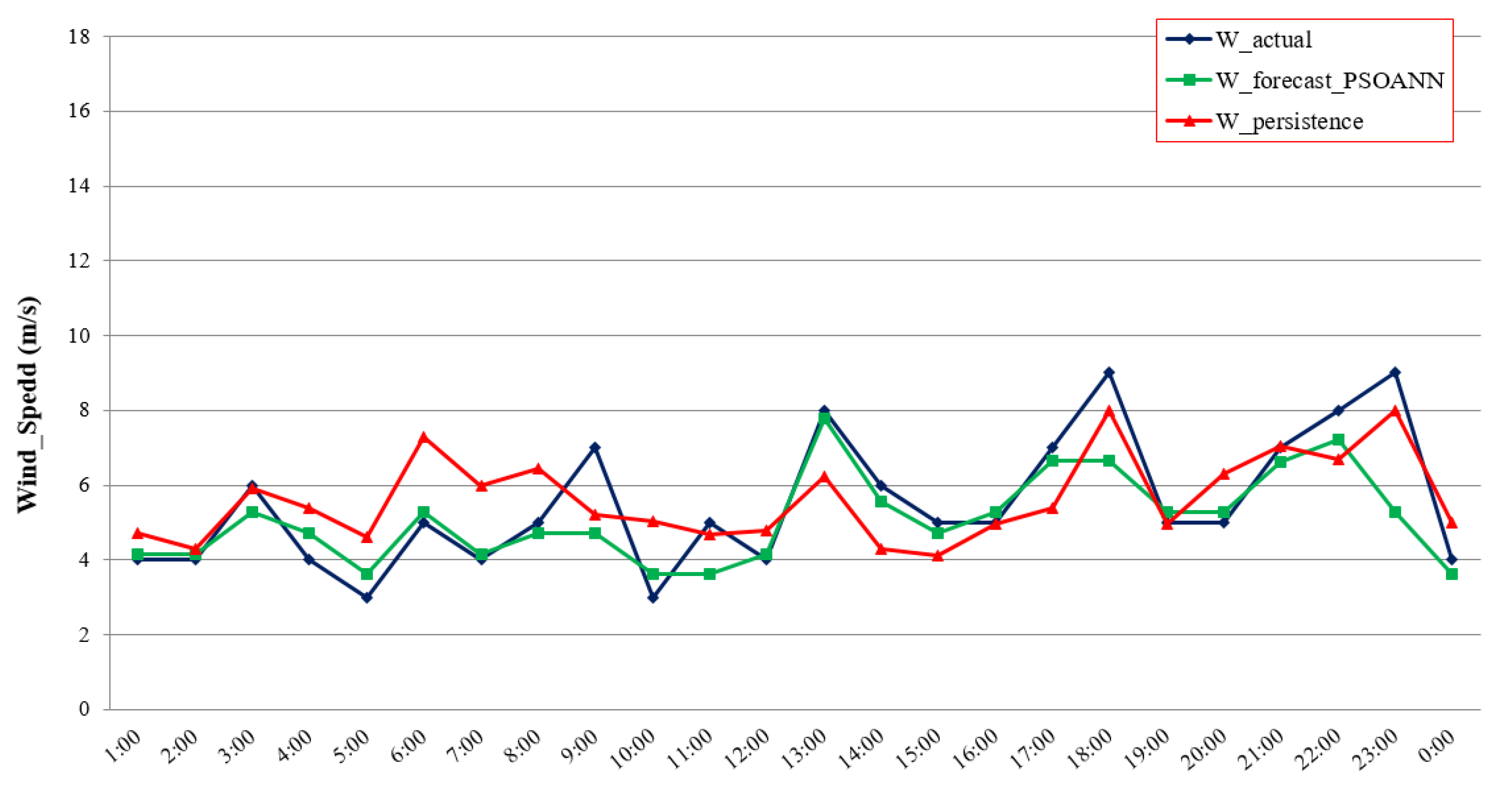
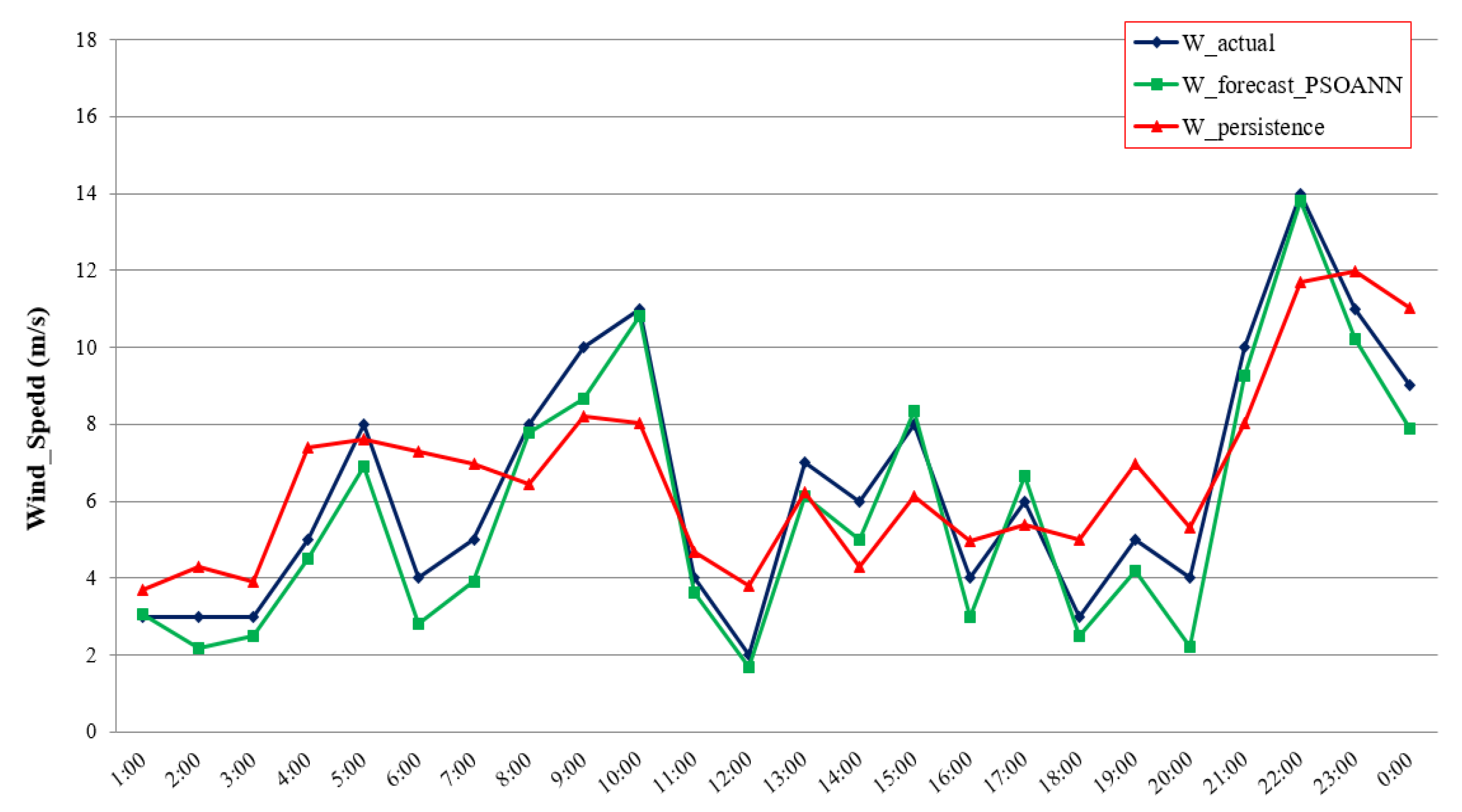
| Model | Cluster 1 Spring | Cluster 2 Autumn | Cluster 3 Summer | Cluster 4 Winter |
|---|---|---|---|---|
| k-means with Pearson’s correlation | 16.98 | 14.54 | 14.14 | 12.78 |
| k-means without Pearson’s correlation | 19.71 | 18.64 | 16.38 | 17.82 |
| Model | Cluster 1 Spring | Cluster 2 Autumn | Cluster 3 Summer | Cluster 4 Winter |
|---|---|---|---|---|
| CPA-WF | 1.43 | 1.08 | 1.12 | 0.84 |
| Persistence | 2.31 | 1.18 | 1.30 | 1.76 |
| Model | Cluster 1 Spring | Cluster 2 Autumn | Cluster 3 Summer | Cluster 4 Winter |
|---|---|---|---|---|
| CPA-WF | 16.98 | 14.54 | 14.14 | 12.78 |
| Persistence | 17.84 | 24.97 | 15.16 | 20.41 |
Disclaimer/Publisher’s Note: The statements, opinions and data contained in all publications are solely those of the individual author(s) and contributor(s) and not of MDPI and/or the editor(s). MDPI and/or the editor(s) disclaim responsibility for any injury to people or property resulting from any ideas, methods, instructions or products referred to in the content. |
© 2023 by the authors. Licensee MDPI, Basel, Switzerland. This article is an open access article distributed under the terms and conditions of the Creative Commons Attribution (CC BY) license (https://creativecommons.org/licenses/by/4.0/).
Share and Cite
Finamore, A.R.; Calderaro, V.; Galdi, V.; Graber, G.; Ippolito, L.; Conio, G. Improving Wind Power Generation Forecasts: A Hybrid ANN-Clustering-PSO Approach. Energies 2023, 16, 7522. https://doi.org/10.3390/en16227522
Finamore AR, Calderaro V, Galdi V, Graber G, Ippolito L, Conio G. Improving Wind Power Generation Forecasts: A Hybrid ANN-Clustering-PSO Approach. Energies. 2023; 16(22):7522. https://doi.org/10.3390/en16227522
Chicago/Turabian StyleFinamore, Antonella R., Vito Calderaro, Vincenzo Galdi, Giuseppe Graber, Lucio Ippolito, and Gaspare Conio. 2023. "Improving Wind Power Generation Forecasts: A Hybrid ANN-Clustering-PSO Approach" Energies 16, no. 22: 7522. https://doi.org/10.3390/en16227522
APA StyleFinamore, A. R., Calderaro, V., Galdi, V., Graber, G., Ippolito, L., & Conio, G. (2023). Improving Wind Power Generation Forecasts: A Hybrid ANN-Clustering-PSO Approach. Energies, 16(22), 7522. https://doi.org/10.3390/en16227522










